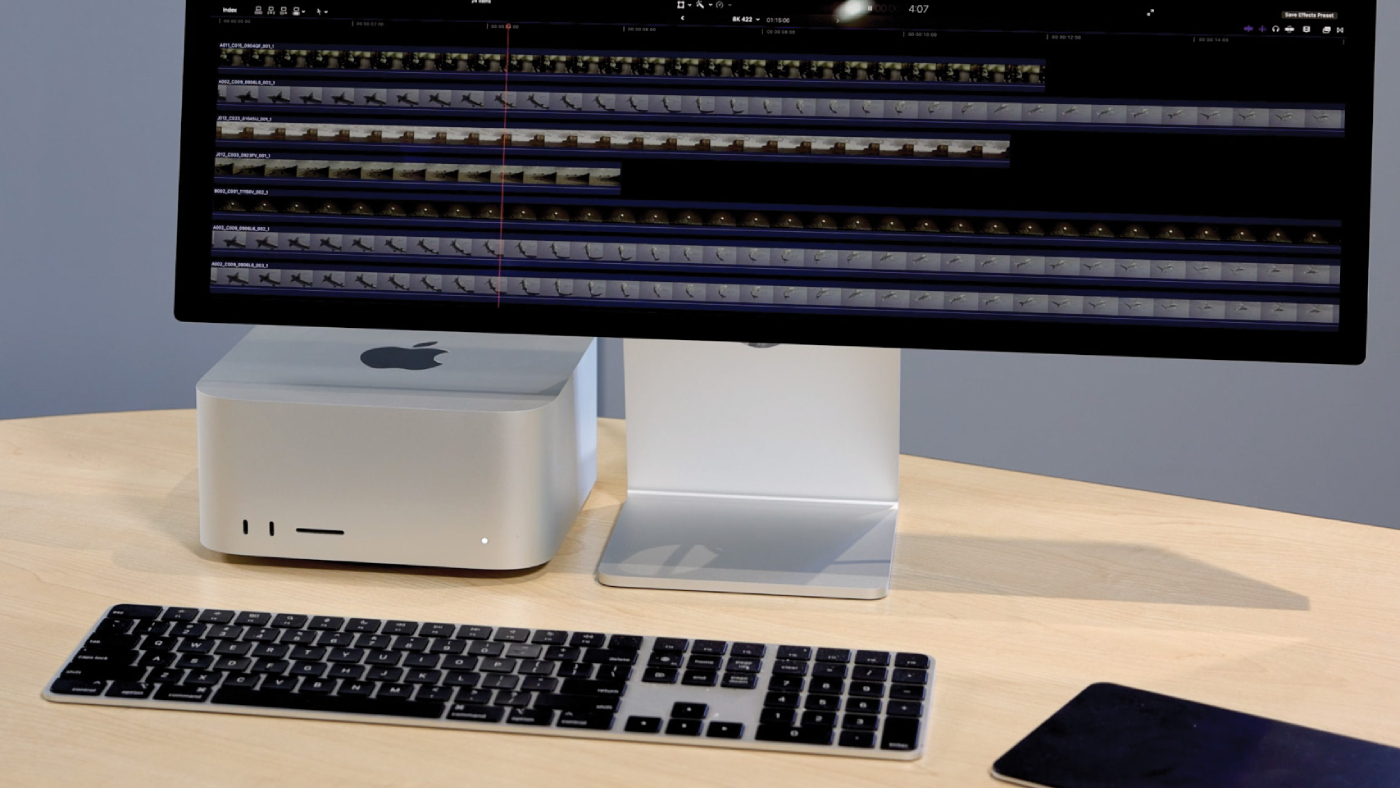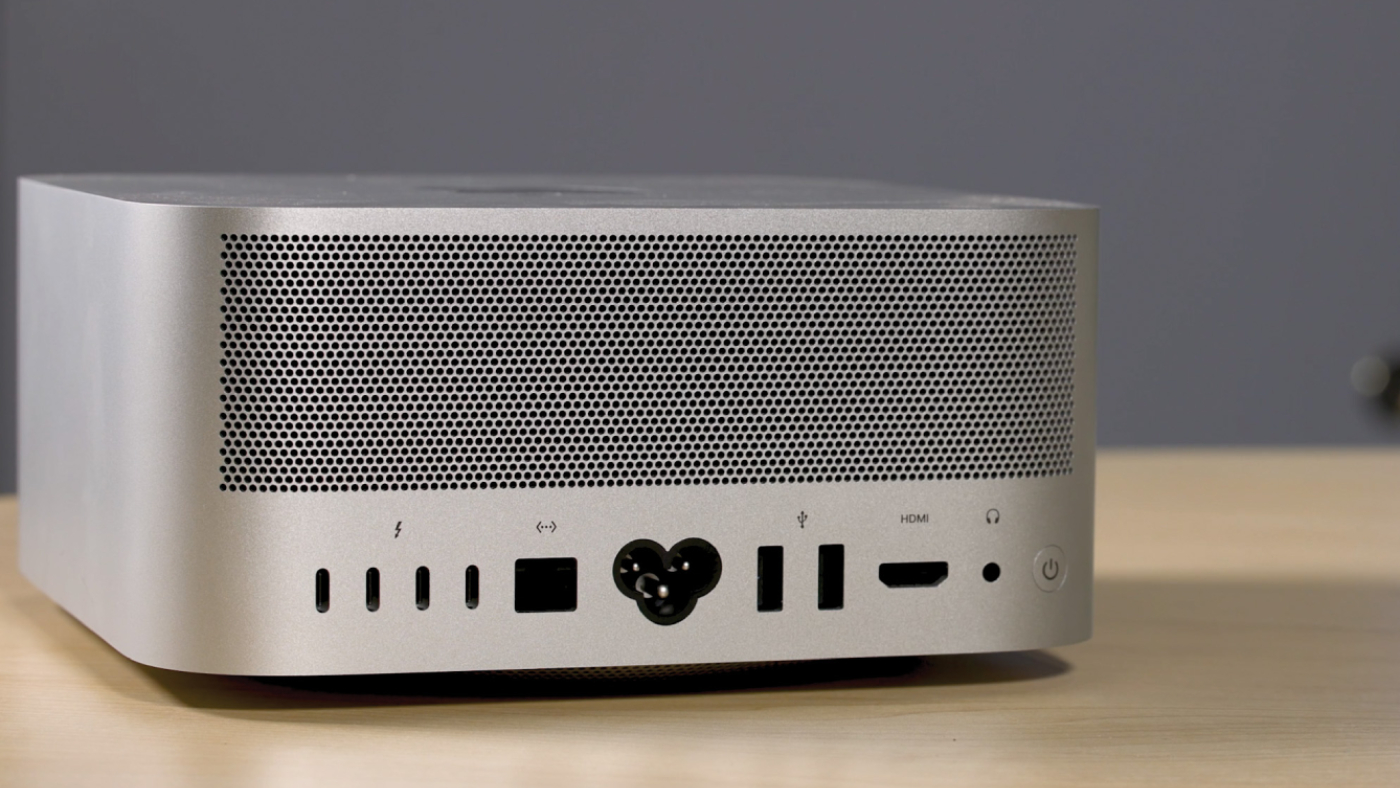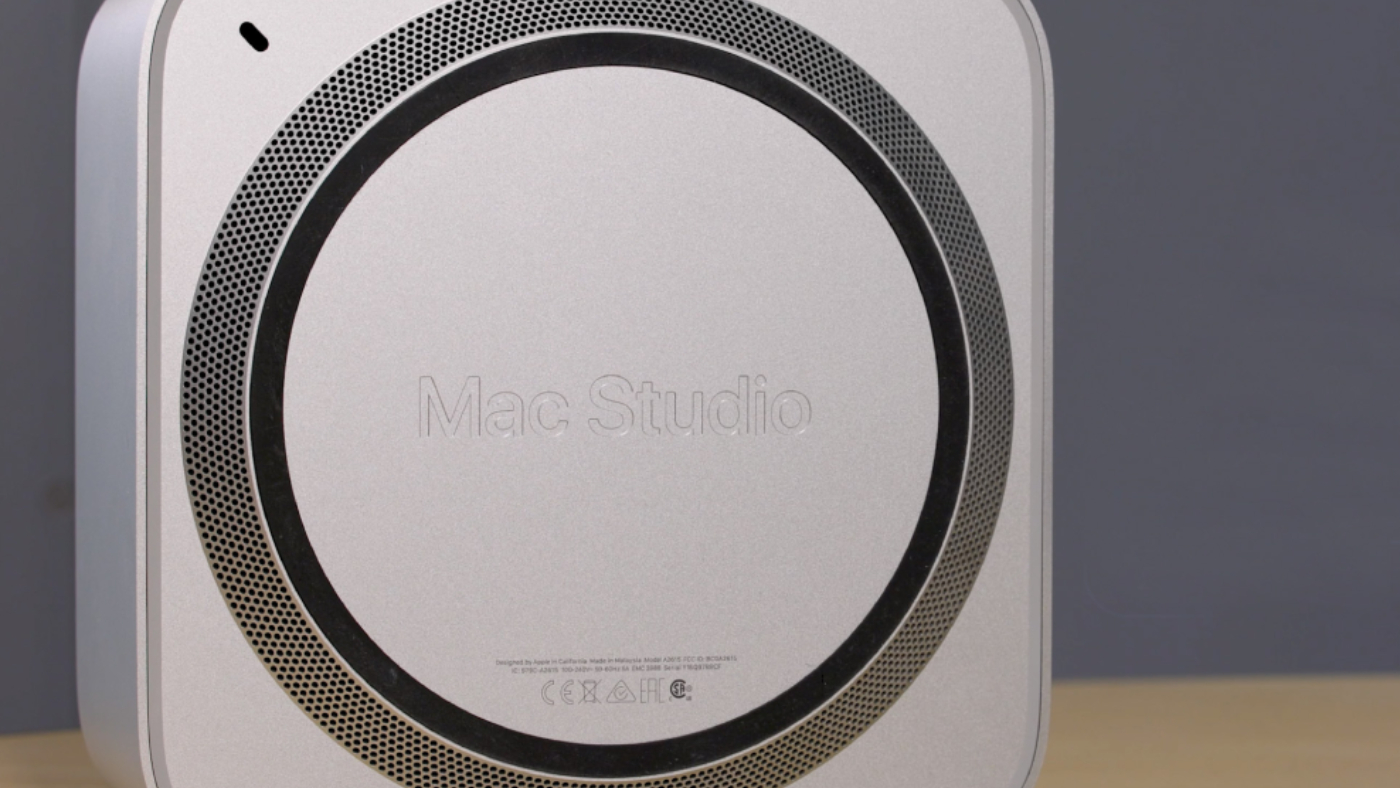The new Apple Mac Studio is here, and from the outside, it looks familiar. Inside, however, you’ll find one of Apple’s new M1 Max or M1 Ultra processors. Considering the hardware and the $2,000 base price, the Mac Studio offers great value. But who will get the most out of this compact desktop computer? And is the Mac Studio a good choice for video editors? Read on to learn everything a video producer needs to know about the new Apple Mac Studio.
In this review, we’re going to talk about all of the details of the Mac Studio. We’ll talk about system configuration options along with the Mac Studio’s form factor and design, and we’ll also touch on the Studio Display. After that, we’ll highlight some of the pros and cons of the Mac Studio before digging into our testing process and the results we observed. Specifically, we’ll explore the differences between these new Apple M1 systems and the older systems with the Intel chips. Then, we’ll compare how Final Cut Pro and Premiere Pro perform on the new systems. Finally, we’ll get to our opinion as video editors and finish with our purchasing recommendation.
A closer look at the Mac Studio

Let’s start off with a simple product introduction. The Mac Studio can be fitted with either an M1 Max or the more powerful M1 Ultra. With these ARM-based chips, Apple combines the central processing unit and graphic processing unit into a single chip. Both Mac Studio systems also use unified memory. That means the CPU and GPU both operate off the same memory pool.
Mac Studio M1 Max
Starting out at $2,000, the Mac Studio M1 Max offers more or less what you’d expect from Apple at this price point. It’s similar in configuration to the MacBook Pro, but it nixes the monitor in favor of an impressively compact desktop form factor. The M1 Max features a 10-core CPU, 24- or 32-core GPU and 16-core neural engine. The system can be configured with either 32 of 64 GB of unified memory and up to 8 TB of solid-state storage.
Mac Studio M1 Ultra
For an upgraded option, look to the Mac Studio M1 Ultra. With the M1 Ultra, you essentially get two M1 Max chips connected together. It’s actually pretty cool: The M1 Ultra is, in fact, just two M1 Maxes together, and Apple can connect them so that they work together as a single chip. Thus, the M1 Ultra system offers a 20-core CPU, 32-core neural engine and either a 48- or 64-core GPU. Plus, the M1 Ultra allows configurations with up to 128 GB of unified memory along with up to 8 TB of SSD storage. The M1 Ultra also comes with lower power consumption than a lot of its competition.
What’s different between the two systems?
Now let’s talk about the configurations of this system. As we can see, there are two tiers here. You have the M1 Max and the M1 Ultra. The first one, the M1 Max, starts at $2,000. For that, you get the 10-core CPU, the 24-core GPU and the 16-core neural engine. At that price point, you also get 32 GB of unified memory and 512 GB of SSD storage. Upgrading to the 32-core GPU version of the M1 Max and 64 GB of unified memory pushed the price up to around $2,600. Fully loaded with 8 TB of SSD storage, M1 Max configurations top out at just under $5,000.
Now, the M1 Ultra configurations of the Mac Studio start at $4,000 and go all the way up to $8,000, depending on a few different things. Like the M1 Max, there are two versions of the M1 Ultra available. Both have a 20-core CPU and 32-core neural engine, but one version offers a 48-core GPU while the other has an upgraded 64-core GPU. That’s really the biggest difference. Either version of the M1 Ultra will support up to 128 GB of unified memory.
The most obvious difference between these systems is the performance increase from the more powerful M1 Ultra. Aside from that, the M1 Max and the M1 Ultra are nearly identical. However, do note that the front ports on the M1 Max system are USB-C, while the M1 Ultra features Thunderbolt 4 connections.
As we went through the different configurations, it was clear that boosting storage capacity was the easiest way to inflate the cost of the system. While Apple offers up to 8 TB of internal solid-state storage, maxing out the internal storage will set you back an atrocious $2,400. For most, finding a more affordable external storage solution will make a lot more sense.
Configuring the Mac Studio for video editing

There are a few different options when it comes to the Mac Studio, so how would you configure it best for video editing? What is necessary and what isn’t? Specifically, you might be wondering if you could get by with just the M1 Max. It’s a great chip, but if you really want to get that extra value, we suggest upgrading to the M1 Ultra. If you’re trying to buy a system that’s going last long into the future, it would be better to save money by opting for less memory. 128 GB of memory is generally overkill; 64 GB will handle almost any job.
The other cost-saving tip is to avoid upgrading Apple’s internal storage. We’d go with the 1 TB option and then expand our storage capacity with external drives or a separate RAID. For the same money, you can get a lot more storage. It’s true that you’re not going to get quite the same speed read and write speeds, but at the moment, there isn’t much need for speeds up to 600 Mbps outside of specialized use cases. A configuration like this would be around $4,000. It’s just really the entry-level Mac Studio with an M1 Ultra, and it’s a great system.
Studio Display
Now let’s talk about Apple’s Studio Display. First things first: It’s $1,600 — that’s the base price. If you want a nano-texture or a different mount with height adjustment, that’s going to cost you more than the standard $1,600 starting price.
The model we used in our review process Studio Display features a 5K Retina display with 218 pixels per inch and 600 nits of brightness. The monitor is bright but not quite bright enough to qualify as HDR-ready. That requires a 1000-nit brightness. The Studio Display connects via a Thunderbolt 3 port, and it also offers three USB-C ports as a hub. One odd connectivity note: the power cord doesn’t disconnect. This is kind of strange for a monitor of this price, but at least the attached cord looks to be high quality.
The Apple Studio Display also has a built-in six-speaker sound system with Spatial Audio and three different mics. This setup sounds pretty good, and it’s quite loud. We also noted that the mic is very clear when used on a video call or something like that.
And then lastly, this monitor has a built-in webcam. This is the same webcam we’ve seen in the iPad, which includes Center Stage. This keeps users centered in the frame as they move around. And when others join or leave the call, the view expands or zooms in.
The good and the bad of the Mac Studio
Now that we have introductions out of the way, it’s pros and cons time.
Pros
First pro: The Mac Studio is super quiet. With this system, you wouldn’t even know it’s on if not for the light on the front. That makes it super nice in applications where you can’t have a loud computer.
Second pro: It’s really powerful. Apple touts 18 streams of 8K ProRes 422. We tested this claim, so look for the results later in the review.
And then the last pro: The Mac Studio has lots of ports, especially considering its size. Unlike the MacBook Pro, the Mac Studio offers more than just USB-C and Thunderbolt inputs. In fact, you get Thunderbolt 4 ports and USB-C ports, as well as an SD card reader and two USB Type-A ports. It also has an HDMI port and a 3.5 mm headphone jack.

Cons
Now on to the cons. First up, this system is not user-upgradable. In fact, we’re not sure it can be upgraded at all. At present, it looks like you’re not going to be able to change your configuration once you buy, so make sure you figure out the right system for you.
Our next complaint is the borderline-extortionary price of storage for these systems; Apple has always offered really expensive internal storage. In fact, if you want the maximum 8 TB of internal storage in your Mac Studio, it’s going to cost you $2,400. That’s pretty crazy. However, it does promise read and write speeds of 6000 Mbps to that internal storage, which is just blazing fast. Do you actually need it that fast? Maybe. Maybe not.
The last con, which applies to the entire Apple ecosystem, is that Apple doesn’t offer full support for third-party applications. Right now, programs and apps that were written for Macs with Intel chips continue to work on these new M1 systems thanks to something called Rosetta 2. In our tests, this dynamic translator performed well. In fact, we encountered only a few applications that wouldn’t work on the system. However, Rosetta 2 did come with some performance downgrades. Because Rosetta 2 serves as a compatibility layer in between the different instruction sets, you aren’t able to really take advantage of the full power of these new chips. This becomes more obvious when comparing Apple’s Final Cut with something like Adobe Premiere Pro. We’ll talk more about that next.
Video editing performance
Let’s get into the most important question about this system: Is it a good choice for video editing? And with this particular system, we’ll also need to ask a secondary question: How well does it perform when you’re not using Apple’s Final Cut Pro?
As you might guess, when you’re using Final Cut Pro, the Mac Studio works amazingly well. So, if your workflow is Final Cut-based — it’s awesome. You’re going to get the best performance the system can actually give. Apple has really designed these two products to work well together — hardware and software.
We compared the Mac Studio’s performance using Final Cut Pro to that when editing in Premiere Pro, which is what we use around Videomaker to do most of our video editing. We wanted to see how much of a performance boost you get from working inside the Apple ecosystem.
The differences are most obvious in each program’s ability to playback high-resolution video. We ran tests in both programs using footage in ProRes RAW, ProRes 422, R3D (Red’s RAW codec) and Canon Cinema RAW Light — all in 8K — to see how they did.
Test results

Right off the bat, the ProRes RAW did a little bit better in Final Cut than in Premiere Pro, but it’s still quite efficient anyway. We were able to playback 13 streams of 8K ProRes RAW in Final Cut Pro versus only 10 streams in Premiere Pro. Now when we move over to ProRes 422, we started to see much bigger gains. Final Cut Pro was able to support 18 8K streams simultaneously; they all played back without dropping frames. That’s amazing. We were not able to get the same performance out of Premiere, which only supported five simultaneous streams in ProRes 422.
We also perform the same test using 8K R3D footage. In this format, we saw up to five streams in Final Cut, but we couldn’t get even one to play back smoothly in Premiere Pro. Next up was Canon’s Cinema RAW Light in 8K, and again, we couldn’t even get one stream to play properly in Premiere Pro. However, Final Cut Pro could handle up to five streams of 8K Cinema RAW Light.
As you can see from these results, the performance boost is actually a big deal if you’re a Final Cut user. If you’re a Premiere user, it’s likely Adobe will add performance upgrades in the future that take advantage of that hardware and how it’s all designed. Of course, that’s only speculation. Right now, Apple really takes the cake.
Is the Apple M1 chip worth it?
For a long time now, we’ve had AMD and Intel competing in the CPU space, while AMD and Nvidia have duked it out over GPUs. And that was that. Intel does have some integrated graphics, but they’re not at all trying to compete with high-end dedicated graphics cards. With the new system-on-a-chip design, the Apple M1 Max and the M1 Ultra start to break up this existing market structure.
Now, with all that said, what does it mean? Well, it means that you now have more options when buying a Mac. There is the Intel option, but now we also have the Mac silicon option. And right now, Apple’s chips offer a significant value over any of those Intel products. If you look at, say, the Mac Pro — also known as the cheese grater — you can, of course, configure that system to have much more power than the Mac Studio here.
However, for the money, you get a little bit more performance from the Mac Studio with the M1 chips. If you were to build the two systems comparably, you might actually pay less for the Mac Studio. Plus, in a lot of cases, the number of CPU and GPU cores along with the unified memory will end up giving you better performance. The price-per-core is extremely low, and having that much memory available for both the CPU and GPU is just fantastic. The unified design is a great idea and unique in the marketplace.
Everyday use
For the last month or so, we’ve used the Mac Studio daily here in the office, and it’s absolutely been a great system. We haven’t had any compatibility issues, but we were a little frustrated at the performance differences noted above. It would be great if third-party programs were optimized to work directly with Apple’s new silicon. But we’re sure we’ll see that soon. That’s really the only drawback we see currently. We’re going to keep the Mac Studio around for a while since it’s definitely a really capable machine.
As for the Studio Display, we really liked it, but there are likely other displays out there that are far better for less money. It looks nice. It works well with the Apple ecosystem. The minimal aesthetic is certainly appealing if you use the Mac Studio and Studio Display together. However, it’s definitely not necessary. There’s a lot more value out there to be found if you’re shopping around for monitors.
Final thoughts
Okay, here comes our final thoughts: Should you buy this system? We’ve already pointed out the fact that you can configure the Mac Studio up to around $8,000. Add in the monitor, which can be up to around $2,000, and you have a $10,000 system at the top end. However, even though the cost of the Mac Studio can inflate quickly, it can also be pared back to around $3,500 for a more modest system. That’s still no small chunk of change, but it’s a good value for what you’re getting: a system that can handle editing really well, especially with the right software.
The Mac Studio is a nice complement to the Mac Pro, which can be quite expensive when you add in all the bells and whistles. Along with that, Apple offers an amazing, huge, expensive monitor to pair with that system. Cue the Mac Studio and the Studio Display, both offering more-than-adequate performance at a more modest price point.
Now, here is the catch: If you are a Final Cut Pro user, this system’s going to just blow your mind. The performance difference against third-party editors like Premiere Pro is striking. It’s that hardware-software integration that makes the Mac Studio so impressive. If you enjoy working in the Apple ecosystem, this is what we’ve been waiting for.
Summary
Strengths
- Performance gains in Apple software
- Unified memory shared across CPU and GPU
Weaknesses
- Weaker performance in third-party software
- Not user-upgradeable
Recommended uses
- Narrative Filmmaking
- Corporate video
- Marketing
- Online video
Tech specs
| Processor model | Apple M1 Ultra |
| Processor model number | M1 Ultra |
| Cores | 20-core CPU with 16 performance cores and 4 efficiency cores |
| GPU | 48-core GPU |
| Engine | 32-core Neural Engine |
| Memory bandwidth | 800 GB/s |
| Memory | 64 GB (configurable to 128 GB) |
| Storage | 1 TB SSD (configurable to 2 TB, 4 TB or 8 TB) |
| Total storage capacity | 1000 gigabytes |
| Solid state drive capacity | 1000 gigabytes |
| System memory | 64 gigabytes |
| System memory RAM expandable to | 128 gigabytes |
| Graphics | Apple M1 Ultra 48-core |
| Operating system | Mac OS |
| Graphic type | Integrated |
| GPU brand | Apple |
| Graphics | Apple M1 Ultra 48-core |
| Operating system | Mac OS |
| Internet connectivity | Ethernet, Wi-Fi |
| Built-in speaker | Yes |
| 3.5 mm headphone jack | Yes |
| HDMI ports with support for multichannel audio output | Yes |
| Product height | 3.7 inches |
| Product width | 7.7 inches |
| Product depth | 7.7 inches |
| Product weight | 7.9 pounds |

